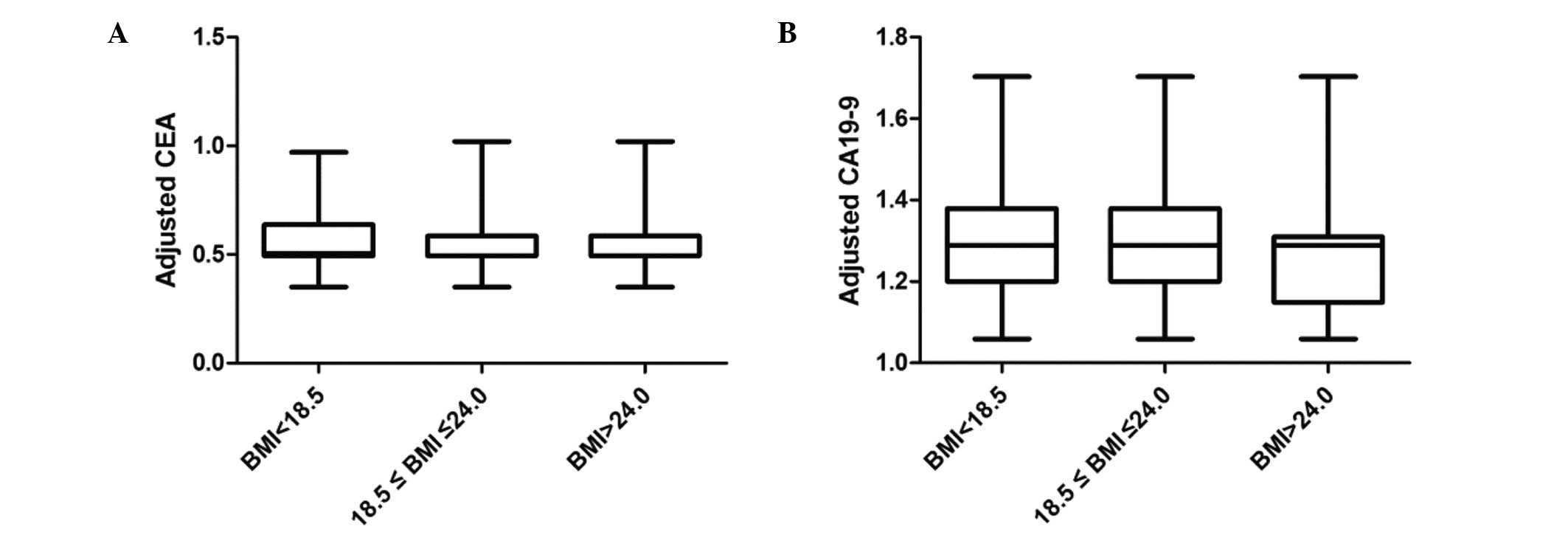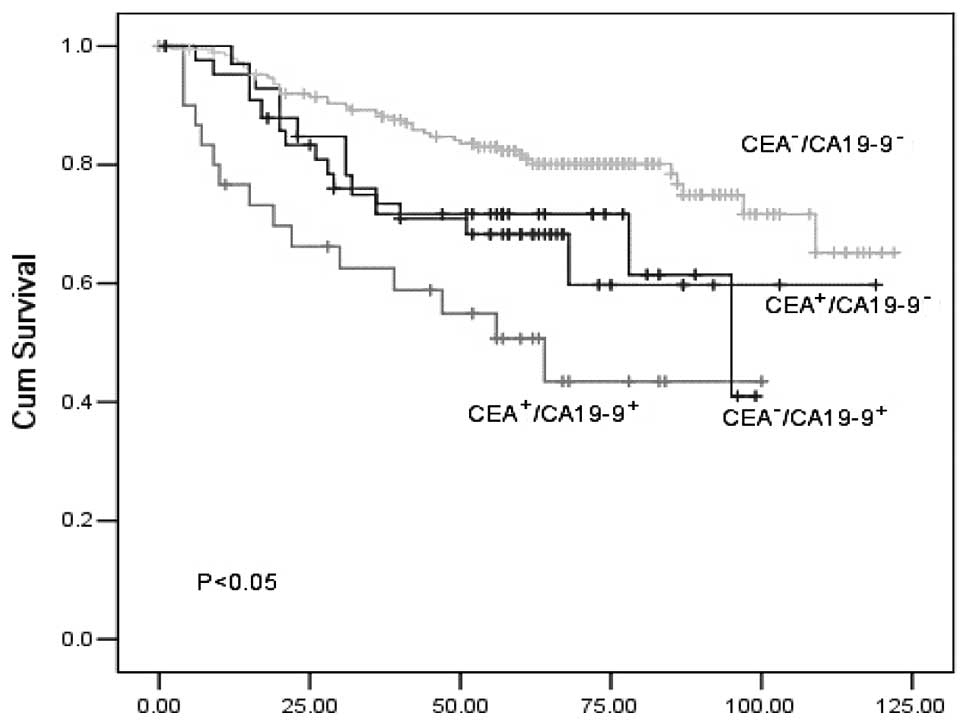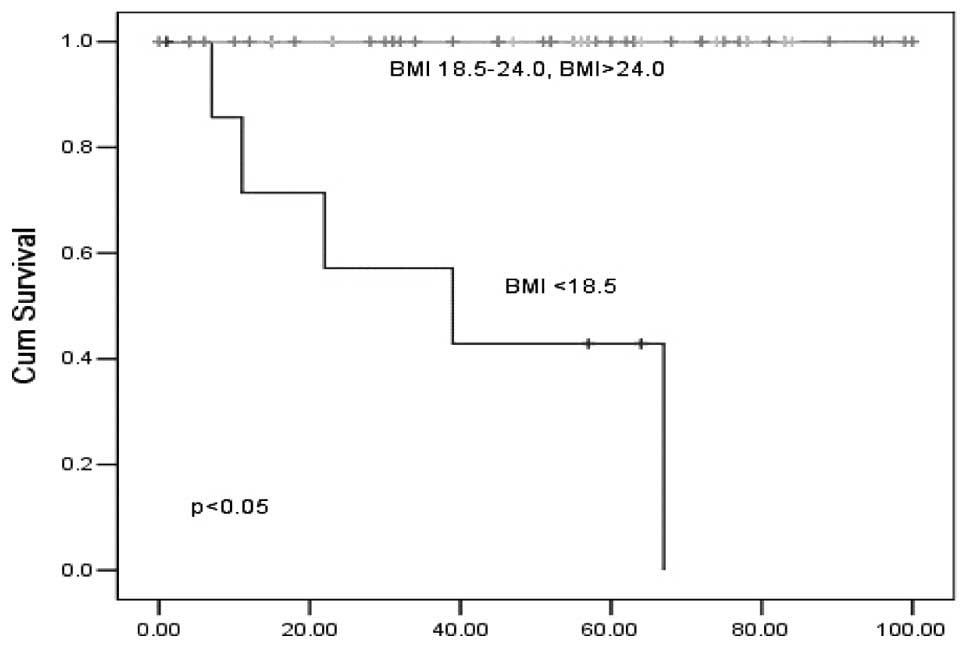|
1
|
Duffy MJ: Carcinoembryonic antigen as a
marker for colorectal cancer: is it clinically useful? Clin Chem.
47:624–630. 2001.PubMed/NCBI
|
|
2
|
Lee SH, Ahn BK, Baek SU and Chang HK: BRAF
mutation in multiple primary cancer with colorectal cancer and
stomach cancer. Gastroenterol Rep. 1:70–74. 2013. View Article : Google Scholar : PubMed/NCBI
|
|
3
|
Chen CC, Yang SH, Lin JK, et al: Is it
reasonable to add preoperative serum level of CEA and CA19-9 to
staging for colorectal cancer? J Surg Res. 124:169–174. 2005.
View Article : Google Scholar : PubMed/NCBI
|
|
4
|
Marrelli D, Caruso S, Pedrazzani C, et al:
CA19-9 serum levels in obstructive jaundice: clinical value in
benign and malignant conditions. Am J Surg. 198:333–339. 2009.
View Article : Google Scholar : PubMed/NCBI
|
|
5
|
Wanebo HJ, Rao B, Pinsky CM, et al:
Preoperative carcinoembryonic antigen level as a prognostic
indicator in colorectal cancer. N Engl J Med. 299:448–451. 1978.
View Article : Google Scholar : PubMed/NCBI
|
|
6
|
Staab HJ, Anderer FA, Stumpf E, et al:
Eighty-four potential second-look operations based on sequential
carcinoembryonic antigen determinations and clinical investigations
in patients with recurrent gastrointestinal cancer. Am J Surg.
149:198–204. 1985. View Article : Google Scholar
|
|
7
|
Ballesta AM, Molina R, Filella X, et al:
Carcinoembryonic antigen in staging and follow-up of patients with
solid tumors. Tumor Biol. 16:32–41. 1995. View Article : Google Scholar : PubMed/NCBI
|
|
8
|
Fukuda I, Yamakado M and Kiyose H:
Influence of smoking on serum carcinoembryonic antigen levels in
subjects who underwent multiphasic health testing and services. J
Med Syst. 22:89–93. 1998. View Article : Google Scholar
|
|
9
|
Amino N, Kuro R, Yabu Y, et al: Elevated
levels of circulating carcinoembryonic antigen in hypothyroidism. J
Clin Endocrinol Metab. 52:457–462. 1981. View Article : Google Scholar : PubMed/NCBI
|
|
10
|
Bulut I, Arbak P, Coskun A, et al:
Comparison of serum CA 19.9, CA 125 and CEA levels with severity of
chronic obstructive pulmonary disease. Med Princ Pract. 18:289–293.
2009. View Article : Google Scholar : PubMed/NCBI
|
|
11
|
Witherspoon LR, Shuler SE, Alyea K and
Husserl FE: Carcinoembryonic antigen: assay following heat compared
with perchloric acid extraction in patients with colon cancer,
non-neoplastic gastrointestinal diseases, or chronic renal failure.
J Nucl Med. 24:916–921. 1983.
|
|
12
|
Herbeth B and Bagrel A: A study of factors
influencing plasma CEA levels in an unselected population. Oncodev
Biol Med. 1:191–198. 1980.PubMed/NCBI
|
|
13
|
McLaughlin R, O’Hanlon D, Kerin M, et al:
Are elevated levels of the tumour marker CA19-9 of any clinical
significance? - an evaluation. Ir J Med Sci. 168:124–126. 1999.
View Article : Google Scholar : PubMed/NCBI
|
|
14
|
Chang IH, Ahn SH, Han JH, et al: The
clinical significance in healthy men of the association between
obesity related plasma hemodilution and tumor marker concentration.
J Urol. 181:567–573. 2009. View Article : Google Scholar : PubMed/NCBI
|
|
15
|
Banez LL, Hamilton RJ, Partin AW, et al:
Obesity-related plasma hemodilution and PSA concentration among men
with prostate cancer. JAMA. 298:2275–2280. 2007. View Article : Google Scholar : PubMed/NCBI
|
|
16
|
Vollmer RT and Humphrey PA: Tumor volume
in prostate cancer and serum prostate-specific antigen. Analysis
from a kinetic viewpoint. Am J Clin Pathol. 119:80–89.
2003.PubMed/NCBI
|
|
17
|
Korner H, Soreide K, Stokkeland PJ, et al:
Diagnostic accuracy of serum-carcinoembryonic antigen in recurrent
colorectal cancer: a receiver operating characteristic curve
analysis. Ann Surg Oncol. 14:417–423. 2007. View Article : Google Scholar
|
|
18
|
Park JS, Choi GS, Jang YS, et al:
Influence of obesity on the serum carcinoembryonic antigen value in
patients with colorectal cancer. Cancer Epidemiol Biomarkers Prev.
19:2461–2468. 2010. View Article : Google Scholar : PubMed/NCBI
|
|
19
|
Forones NM and Tanaka M: CEA and CA19-9 as
prognostic indexes in colorectal cancer. Hepatogastroenterology.
46:905–908. 1999.PubMed/NCBI
|
|
20
|
Sato T, Nishimura G, Nonomura A, et al:
Serological studies on CEA, CA 19-9, STn and SLX in colorectal
cancer. Hepatogastroenterology. 46:914–919. 1999.PubMed/NCBI
|
|
21
|
Gayowski TJ, Iwatsuki S, Madariaga JR, et
al: Experience in hepatic resection for metastatic colorectal
cancer: analysis of clinical and pathologic risk factors. Surgery.
116:703–711. 1994.PubMed/NCBI
|
|
22
|
Ohwaki K, Endo F, Muraishi O, et al:
Relationship between prostate-specific antigen and hematocrit: does
hemodilution lead to lower PSA concentrations in men with a higher
body mass index? Urology. 75:648–652. 2010. View Article : Google Scholar : PubMed/NCBI
|

















